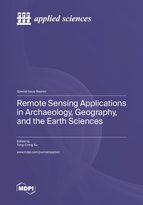Remote Sensing Applications in Archaeology, Geography, and the Earth Sciences
A special issue of Applied Sciences (ISSN 2076-3417). This special issue belongs to the section "Earth Sciences".
Deadline for manuscript submissions: closed (27 May 2023) | Viewed by 23377
Special Issue Editor
Special Issue Information
Dear Colleagues,
Archaeology, geography, and the Earth sciences can be regarded as an integrated field devoted to research about natural, environmental, humanities, and the social sciences. Active and passive remote sensing systems have been widely applied to the data acquisitions of various spatial scales. Innovations in image and signal processing techniques, algorithms, the Internet of Things (IoTs), big data analyses, and deep learning models induce new potentials in reconstruction and exploration of ancient people’s material culture, environment/landscape changes, and natural and humanistic connections.
This Special Issue focuses on applying remote sensing techniques coupled with data mining methods to analyze and discuss contexts among humanities, geographies, and environments. A formal integration of archaeology, geography, and the Earth sciences has been developed for the past twenty or thirty years. In spite of that, continuous innovations, whether in imaging spectroscopy and multimodal imaging or in imaging computing using deep learning models, still motivate scholars to address the related issues.
The aim of this Special Issue is to compile the latest achievements in the topic and to open up a forum where scholars can contribute their unique findings. Potential topics include but are not limited to the ones covered in the keywords.
Prof. Dr. Tung-Ching Su
Guest Editor
Manuscript Submission Information
Manuscripts should be submitted online at www.mdpi.com by registering and logging in to this website. Once you are registered, click here to go to the submission form. Manuscripts can be submitted until the deadline. All submissions that pass pre-check are peer-reviewed. Accepted papers will be published continuously in the journal (as soon as accepted) and will be listed together on the special issue website. Research articles, review articles as well as short communications are invited. For planned papers, a title and short abstract (about 100 words) can be sent to the Editorial Office for announcement on this website.
Submitted manuscripts should not have been published previously, nor be under consideration for publication elsewhere (except conference proceedings papers). All manuscripts are thoroughly refereed through a single-blind peer-review process. A guide for authors and other relevant information for submission of manuscripts is available on the Instructions for Authors page. Applied Sciences is an international peer-reviewed open access semimonthly journal published by MDPI.
Please visit the Instructions for Authors page before submitting a manuscript. The Article Processing Charge (APC) for publication in this open access journal is 2400 CHF (Swiss Francs). Submitted papers should be well formatted and use good English. Authors may use MDPI's English editing service prior to publication or during author revisions.
Keywords
- Environmental/landscape archaeology
- Human geography
- Active/passive remote sensing techniques
- Geographic information systems
- 2D and 3D data processing for story mapping
- Spatial analysis
- Deep learning and data mining
- Historical scene reconstruction
- Detection and monitoring of environment/landscape changes
- Documentation, risk assessment, and conservation for cultural heritage






